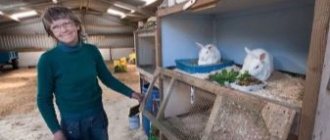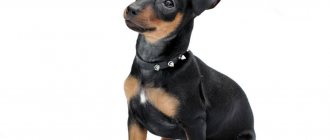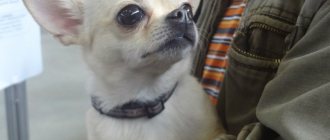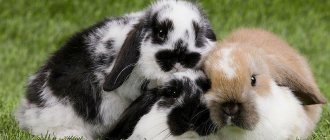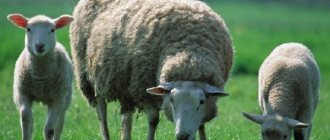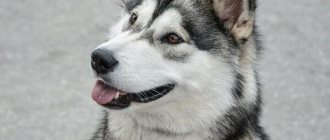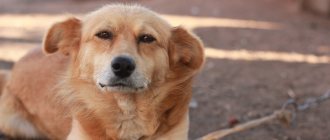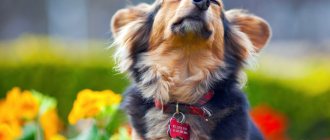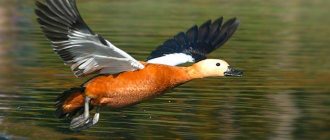Rabbits of the Ram breed are common among lovers of ornamental animals.
They have an unusual appearance, well-developed muscle mass, a peaceful disposition, and are easy to train.
The average life expectancy with proper care is 10 years. The breed has several varieties. Each subspecies has its own characteristics, but they are united by large drooping ears.
Description of the fold breed
The Ram Rabbit is a fairly easy breed to care for and breed . It can be classified as both meat and down varieties, but to a greater extent it is considered a decorative breed. The animals got their name due to the similarity of a rabbit's head with a ram's muzzle. They are distinguished by fast growth, large size, a hump on the nose and long ears.
Not so long ago, the breed was popular only among farmers who were attracted by its unpretentiousness, rapid development of individuals, excellent fur and tender dietary meat. Rabbits of this breed are readily bred as pets because they have a peaceful, friendly character.
Thanks to their high intelligence, they understand commands, but subject to attachment to the owner. Animals are not shy because they have difficulty hearing due to their covered ears. But despite this, you should protect them from sharp sounds, otherwise it will be difficult for them to perceive a person.
Rabbits of the Ram breed are considered one of the most productive meat animals. In almost every country, farmers breed a certain subspecies of the breed. In Russia, the animals became popular 20 years ago.
Effect on the growth of a rabbit's milk production
Favorable conditions for a high growth rate of animals are the high milk production of the female and her responsible attitude to the feeding process. The increased growth after such a push will continue even after the young are separated from their mother.
Rabbit milk is a high-calorie product containing all the necessary vitamins and minerals. Rabbits born in the summer will be provided with higher quality milk than with spring offspring. Milk production is somewhat reduced when birth occurs for the first time. The Californian breed and Soviet chinchillas have the best milk production indicators. Females with this indicator have a longer body and wider chest coverage.
History of appearance
The breed was first introduced at the end of the 19th century in England. Ram rabbits were bred from mammals of the Zaitsev family , which inhabited the Mediterranean and Western Europe.
The main mutational characteristic of the breed (long drooping ears) was obtained by accident.
Subsequently, it was consolidated during breeding work with Flemish Giant and English Fold rabbits.
Previously, breeders considered floppy ears a mutation, trying to exclude it from the phenotype of animals. However, later it was decided to use this characteristic as a distinctive feature. As a result, many animals appeared with unusually long ears.
Animals with unusual appearance quickly spread throughout the world. Later they tried to cross them with other breeds, so some subspecies of ram rabbits appeared.
Animals have become the most popular in:
- Germany;
- Belgium;
- Netherlands.
Price
You cannot buy a “rabbit in a poke”. Before purchasing, the animal must be carefully examined:
- A healthy pet should have a cold and wet nose;
- the eye sclera should be shiny and clean;
- Frequent scratching and matted fur may indicate fleas;
- An animal that constantly licks the anus and tries to sit on the floor with its backside may be infected with worms;
- Diseases of the internal organs may be indicated by cloudy eyes, protruding bones, and an empty, sagging abdomen;
- Bald spots on the body indicate infection with lichen.
The price of a lop-eared ram rabbit varies depending on the pedigree, beauty and rarity of the breed. An ornamental animal without a pedigree costs from 1 to 2 thousand rubles. A pet-class lop-eared cat costs on average from 1 to 2.5 thousand rubles.
If the owners intend to breed a certain breed, it is necessary to purchase a breed-class rabbit-ram, for which they will have to pay from 2 to 4 thousand rubles.
Handsome men with pedigree displayed at exhibitions (show class) are valued at 3-5 thousand rubles. Prices for beautiful and very rare breeds, for example, Dutch Folds, can reach up to 8 thousand rubles.
The purchase should be made during the period when wool does not grow. This will allow you to carefully examine the coat for bald spots.
Breeding goals
Farmers note the high productive qualities of Ram rabbits. They develop quite quickly and gain mass in a short time. With the right diet, animals already weigh about 2 kg by three months, and more than 5 kg by six months . The slaughter yield reaches 60%, and sometimes more. In addition, experts note the excellent taste of the meat.
Rabbit fur is in great demand. From one carcass they get a skin up to 70 cm long. They are used to make fur products. The fur is very soft and high quality, but slightly inferior in thickness to chinchilla. Unlike other breeds, the ram rabbit can come in a variety of colors, including spotted. This is another advantage of the breed.
If you get a Ram rabbit as a pet, you should familiarize yourself with the care and maintenance features in advance.
As a rule, owners do not encounter problems because :
- animals are unpretentious;
- not demanding on diet;
- calm and peaceful.
They recognize their owner and are ready to play with him, following basic commands for a treat - fresh pieces of vegetables or fruits.
Feeding rabbits
Proper feeding of rabbits is no less important factor in the health of the animals than their care and maintenance. There are no special dietary requirements; lop-eared rabbits are fed the same food as normal rabbits. Menu includes:
- Fresh green grass
- Concentrates – wheat, barley grains, rye, oats
- Vegetables – carrots, boiled potatoes, cabbage leaves, zucchini, cucumbers
- Fruits – seedless apples, pears, bananas
- Hay in the cold season
- Branches of rowan, maple, oak, willow, apple, pine, fir tree
There should always be fresh water in the cage. We must not forget about mineral supplements. Rabbits are given chalk, salt stone or special ready-made complexes. If necessary, vitamins are included in the diet. They are necessary, first of all, for pregnant females and young rabbits. It is also worth feeding animals with vitamins at the end of winter and spring.
Standards
The average weight of rabbits is from 4 to 10 kg, the body length is more than 70 cm. The head is massive, the forehead is wide, the nose with a small hump, and the cheeks are plump.
But the main feature of rabbits is their long, drooping ears. In some subspecies, the length of the ears reaches 70 cm, the width is 17 cm (at the widest part).
For such individuals, the ears are collected with a clip on the head so that they can move freely around the cage.
The coat color is varied: black, brown, red, smoky and blue. The wool is very thick and of high quality, length – 3 cm. There is a soft, thick undercoat. The paws are powerful and well developed.
Males reach sexual maturity by six months, females by 8 months. There can be 5-7 rabbits in a litter, the maximum number is 12. The average age of slaughter is 4 months. With proper care and maintenance, and a well-composed diet, rabbits live 9-10 years . The maximum age recorded for representatives of this breed is 14 years.
A narrow chest, poorly developed muscle mass, and protruding ears are considered defective. Experts note that purebred animals should have their ears down as early as three months of age. Individuals with ears that are too narrow or short are discarded.
German Ram
Bred by crossing the French Ram and rabbits of native German breeds. A true Aryan, a true German chancellor! Calm, with a composed character. External signs: heavy lower jaw, tightly built body. A characteristic feature is a rounded “crown” of fur between the ears.
Rabbit breed German ram photo
Rabbit breed German Ram photo
Ear length is 40-45 centimeters. There are up to 7 rabbits per lamb. As for the color, it can be anything, even cat. However, there are exceptions - the German Ram will never be gray or silver.
Varieties with photos
The breed includes more than 40 subspecies that have distinctive features. The most popular include :
- Dwarf;
- Dutch;
- Plush;
- English;
- German;
- French.
Dutch
The smallest subspecies. The maximum weight of an individual is 1.5 kg . Caging is not possible because animals require a certain temperature that must be maintained.
Dutch sheep's ears are not very long, but they hang down along the animal's cheeks. The body is short and resembles a square. The paws are short and thick, the tail is almost invisible behind the fur. The most common colors are red and white.
Dwarf
Another miniature variety of the breed. The subspecies was bred in the Netherlands, and since then has been considered the most popular in this country. Rabbits are very tame, quickly become attached to humans, can be trained, and get along well with children and other pets.
The weight of an adult reaches 2 kg, length – up to 30 cm. Rabbits differ :
- stocky build;
- wide forehead;
- short but powerful legs.
Plush
Decorative plush or corduroy rabbits are considered a new breed, so clear standards have not yet been established. The main feature of the subspecies is thick, short fur. Animals resemble a plush toy.
The average weight is no more than 3 kg . The back of the animals is wide, the chest is rounded. The forelimbs are short, the ears hang along the head, reaching 35 cm.
English
This is the first subspecies, bred earlier than the others. The body length is 60 cm, the ears can completely cover the rabbit itself, the weight is about 5 kg. Thus, the animals belong to large breeds. The breed standard is a large head , a hump on the nose, and a rounded rear part of the body.
The English sheep is the only subspecies whose representatives do not have cartilage on the back of the head. If it is present, we can talk about a defect in the breed.
In the middle of the 20th century, German rabbits appeared, bred in Germany. They differ from other subspecies by their stocky but compact body, large round head and short neck. The length of the ears is 35 cm. The coat is soft, of medium length, the undercoat is dense, and requires regular brushing.
French
It has a large body, weight – up to 8 kg. The length of the ears reaches 50 cm . This subspecies is characterized by rapid weight gain. It is for this reason that the breed quickly gained popularity. The homeland of the subspecies is England.
Meissen
The smallest species, therefore in Germany representatives of the breed are protected at the state level. It was first introduced at the end of the 19th century in the small German city of Meissen. The breed appeared as a result of crossing English and French fold individuals.
The torso of the animals is slightly elongated, the spine is curved, and the body is quite massive. The weight of an adult is up to 5 kg. A special feature of the breed is its thick, dense coat and skin folds on the face.
Corduroy (plush) Ram
One of the youngest breeds in the world. Bred in Austria and then Canada by crossing the Rex rabbit and miniature Rams. The main feature is wool. It is short, very dense, soft, reminiscent of plush or velor. The rabbit looks like a real toy, and therefore is wildly popular.
Rabbit Velveteen Ram
Rabbit breed Velveteen Ram
The breed is quickly spreading throughout the world. Often these animals are purchased for school-age children in order to instill in a little person a sense of responsibility and love for our smaller brothers.
Contents and diet
It is believed that Ram rabbits are not demanding in care and maintenance. This is true, but due to the large build and large drooping ears, owners should follow some maintenance rules.
First of all, this concerns cells. For animals it is necessary to prepare large pens where they will be comfortable. A cage with dimensions of 1.2x1.2 m is quite suitable. It is desirable that the height of the dwelling be at least 0.9 m.
Since the limbs bear almost the entire load due to the significant body weight, it is necessary to carefully consider the design of the floor. The pen needs dense bedding up to 10 cm high. Otherwise, calluses will appear on the limbs. Hay, sawdust, and paper are suitable as bedding.
The enclosure must be placed in a secluded place, away from noise, sharp sounds, people and animals. It is important to exclude drafts, exposure to heating devices, and cold. The pen should be cleaned daily, along with drinkers and feeders.
Once a week you need to disinfect the cage with special solutions to prevent the spread of infectious diseases. It is also necessary to regularly update the litter.
It is advisable to build a small pen near the cage for walks in the fresh air. Owners should be aware that rabbits should be able to exercise daily. This is a prerequisite for the full development of individuals. It is important to provide a secluded sleeping area in the cage. In addition to the feeder and drinking bowl, you will need a litter tray and accessories for games.
In addition, the owner should perform a number of procedures :
- examination and cleaning of ears;
- combing the coat at least once a week;
- cutting nails every 3-4 months;
- timely vaccination and preventive examination by a veterinarian.
Keeping rabbits for industrial purposes is slightly different. Drinkers should be attached to the walls of the cage, feeders should be remote. Cleaning should be done daily, removing excrement and food debris.
Rabbits are heat-loving animals with weak immunity, so it is necessary to maintain an optimal temperature in the room and monitor humidity. During the winter season, animals must be kept in an insulated barn or transferred to a greenhouse. In the warm season, animals require daily exercise away from direct sunlight.
Adults need to be fed twice a day, and young animals more often. The diet should contain :
fresh grass and hay;- grain crops (oats, wheat, barley);
- twig food;
- as a treat - pieces of vegetables and fruits.
You can feed rabbits with ready-made industrial feed.
Since animals are prone to overeating, the diet must be balanced. Rodents should not be allowed to become obese. There should be only clean water in the cages, which is changed daily. In addition, you need to provide the rabbits with grindstones and chalk.
Breeding
Puberty occurs at six months , from this moment they begin to be used for breeding offspring. For mating, the female is placed next to the male. It is important to ensure that the animals do not become obese, otherwise they will lose sexual activity as obesity develops.
A rabbit's pregnancy lasts about a month. Rabbits give birth to up to 10 young rabbits. Dwarf breeds - no more than 4 kids. Thus, Ram rabbits are not among the breeds that produce large offspring. The female feeds the newborn rabbits with milk for up to twenty days. Then the babies are gradually transferred to an adult diet. Rabbits do not require special care, since female rabbits are good mothers, and the babies have a fairly high survival rate.
Features of care
Lop-eared rabbits are rodents, so they are always on the lookout for something to chew. Therefore, everything that an animal can chew must be removed (especially wiring from equipment). It is recommended to let the animal out to walk around the house for 2-4 hours; the rest of the time the pet can stay in its cage. For a comfortable stay, he needs to create all the necessary conditions.
Key points in caring for an animal:
- The cage should be 5-6 times larger than the rabbit.
- There should be a small house or a large overturned bowl inside where the animal can hide.
- The cat's house should not be in a draft or direct sunlight. But there should be good ventilation and lighting around it.
- Rabbits of this breed are very clean, so keep track of where the animal empties and place a tray there. They easily learn to use the tray, which should be cleaned every day.
- It is better to secure the sippy cup and food bowl in the cage so that the animal does not overturn the containers.
Fold-eared rams love attention, so you need to play with them periodically. For them, you can either buy or make various toys from wood, cardboard or paper yourself. These could be balls, mazes, unnecessary old books that the pet could tear. If a fluffy dog is not given attention for a long time, he may show aggression in order to attract attention to himself.
What diseases are they susceptible to?
The breed is prone to some diseases:
- pododermitis (formation of corns and calluses due to improper floor construction);
- ear injuries;
- digestive tract disorders;
- myxomatosis;
- pasteurellosis;
- hemorrhagic pneumonia.
A number of diseases can be avoided through timely vaccination. The functioning of the digestive tract can be improved with the help of a well-designed diet and daily cleaning of the cage.
For rabbits of this breed, the ears are dangerous. Not only are they injured by their relatives, but the situation is aggravated by the formation of sulfur plugs. If other breeds get rid of wax by actively shaking their heads, then lop-eared individuals must chew a lot so that the ears cleanse naturally.
Ram rabbits should not be dragged by the ears. This could result in serious injury. In severe cases, an abscess may form, which can be treated by opening it. Next, the doctor leaves a drainage hole for the pus to escape. Then it is stitched up. Surgery is accompanied by antibacterial therapy.
Hemorrhagic pneumonia is a disease that is viral in nature. The main symptoms of the disease include:
- convulsions, seizures;
- squeaks;
- mental excitability;
- yellow or red nasal discharge.
The disease is very difficult. As a rule, animals die on the third day after the first signs of pathology appear.
Purchase
Animals should be purchased from a trusted place, where the breeder can provide documents confirming the conformity of the breed. Rabbits switch to adult food at 10-12 weeks, and then they are sold. When purchasing, you should carefully examine the animal and make sure that its appearance matches the exterior of the breed. If in doubt, you should find another seller.
When choosing, it is important to pay attention to the exterior and condition of the animal.
The animal must be active, with no discharge from the eyes, ears or nose, or rashes. Abnormalities in movement also indicate that the rabbit is unsuitable.
Pros, cons, reviews
Reviews from rabbit breeders allow us to compile a list of the advantages and disadvantages of this breed. The advantages include :
peaceful disposition;- high level of intelligence;
- unpretentiousness to living conditions;
- good yield of dietary meat;
- quality fur.
Disadvantages of the breed have also been noted, including a low level of activity during the daytime, weak immunity, and a tendency to ear injuries.
All reviews can be found here, here and here.

